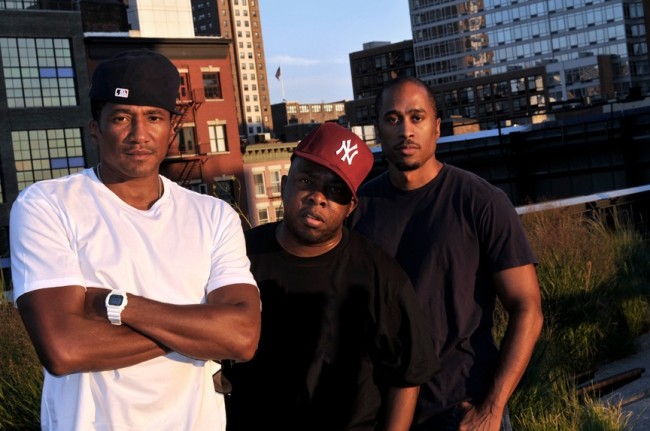Beats Rhymes & Life
Your Favorite Emcee’s Favorite Emcees

Review written by Robert Patrick
The nasally, warbling voice of Michael Rapaport would, for many people who are only mildly familiar with his work, be an unlikely voice for the hip-hop community. Strangely, when Rapaport isn’t playing ill-fated characters in films (he has died more times than Kenny from “South Park” throughout the myriad of movies that he has been in), his heart is anchored to rap music. Rapaport has even lent his naive, squeegee-sounding voice for skits and outtakes on albums from Talib Kweli and Jay-Z. He is, undoubtedly, more popular in the hip-hop community than he is in the shadow of the Hollywood sign. Because of his history with emcees, I was not surprised to learn that he would helm a film about the hip-hop mega-group A Tribe Called Quest. The question would be a simple one: how will Rapaport bridge the lovingly crafted beginning of the group with the barbed, angular ending of their music? If the architecture of your film is wrong, especially if it’s a documentary dealing with musicians, the project becomes a contrite, maudlin, made-for-tv mess that can find its arms bound by the antennas of cable network biographies.
I was worried, not so much for Rapaport, but more for A Tribe Called Quest.
When something is shot, spontaneously, it can be revealing and thoughtful. But if the material isn’t handled well, we start looking at unattractive words such as “exploitative” and “crude.” But many people may be wondering why the group A Tribe Called Quest is such a seminal name in the annals of rap music. The band was a collection of innovative lyricists, playful personalities, wacky subject matter and progressive content. A Tribe Called Quest – led by the silky vocals of Q-Tip; the zig-zag delivery of Phife Dawg; the jazzy buzzing of producer Ali Shaheed Muhammad; and the whatever-the-hell-that-guy-does talents of Jarobi White – were tilting the ice when it came to the then aggressive state of hip-hop in the late eighties and early nineties. Eventually, around the time 1996 came around, the Tribe had less of a union and more of a mutiny on their hands; the group was having differences, and “The Love Movement”, the band’s final record, proved to be the severed brake lines on an otherwise well oiled vehicle.
Rapaport does a decent job of showing the importance of the group’s records, but other than a few lines slung by Q-Tip, describing how the song “Scenario” was made, we aren’t shown much about the band’s thought process when it came to producing. The Tribe’s producer, Ali Shaheed Muhammad, has the least amount of dialogue in the film for some reason (he may as well have been holding the boom mic for everyone else in the documentary). And while the first half of the doc is a live wire of color and sound, the second half, detailing the group’s demise, devolves into MTV “Real World” type confessionals; the guys, specifically Q-Tip and Phife, throw jagged insults at each other when they aren’t behaving passive aggressively. This sort of footage doesn’t make me understand their relationship any better; it only turns the documentary into a murky carousel of “he said” and “she said.” By this time the doc has lost a considerable amount of steam, but the story, even with a juvenile second act marbled with “E! True Hollywood Stories” tropes, manages to delight until the credits roll.
The beauty of Rapaport’s film – and the best decision he made in constructing it – lies in the art of James Blagden, whose work, if he keeps it up, could turn into our generations Saul Bass (you think “Anatomy of a Murder” had a great title sequence? Wait until you see this one). Blagden’s wonky, serpentine lines drop like a nasty curve ball when he recreates some of the Tribe’s memorable album art. There is a sort of staccato, chalky, playful kind of waggle that Blagden employs with his work (check out his interpretation of baseball player Dock Ellis’ no-hitter in the amazing animated short “Dock Ellis and the LSD No-No.”)
Rapaport doesn’t fill in a lot of the blanks for people not entirely familiar with the group, but even so, many will find themselves tapping their feet while simultaneously scratching their head – and maybe that’s not all that bad of a thing. Fans of A Tribe Called Quest will be mostly thrilled, however, especially when talking heads from the hip-hop community show up to talk about the group. Unfortunately, Rapaport is pretty bad with the direction; I don’t know if he was shooting the film while on a trampoline, but most of these shots look like he was playing whack-a-mole with the camera. Whether or not Rapaport used a buoy for a tripod is unknown, but the finished product looks pretty ugly. Ultimately, the movie does it’s job – and mostly well. And there is nothing better than hearing Tribe’s music over a theater’s surround sound system, especially for those of us who weren’t at the group’s last show at Rock the Bells.
